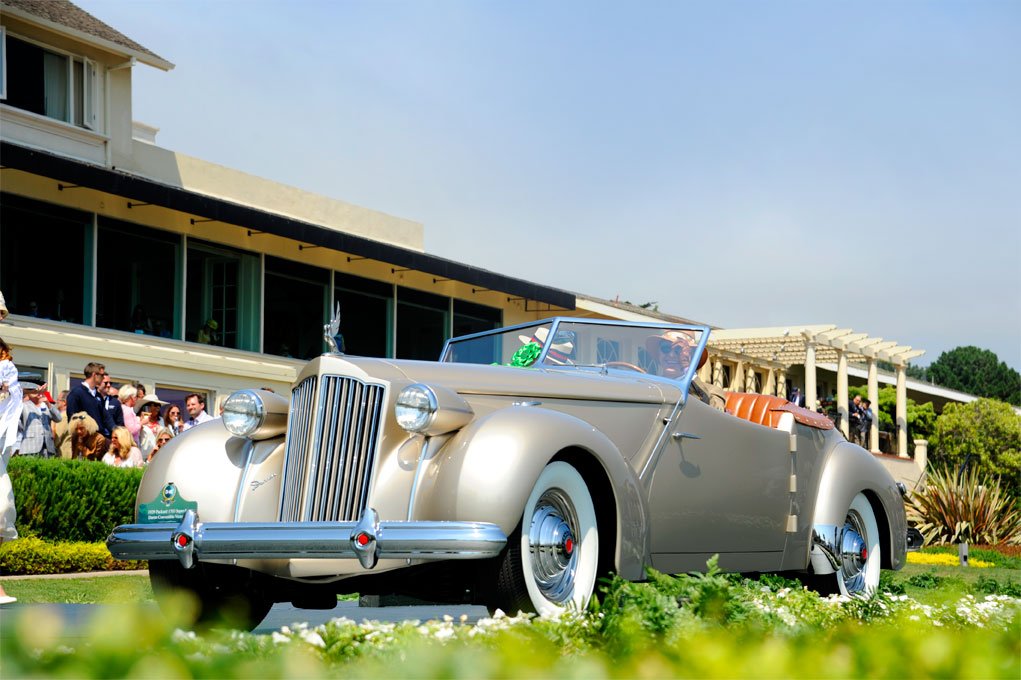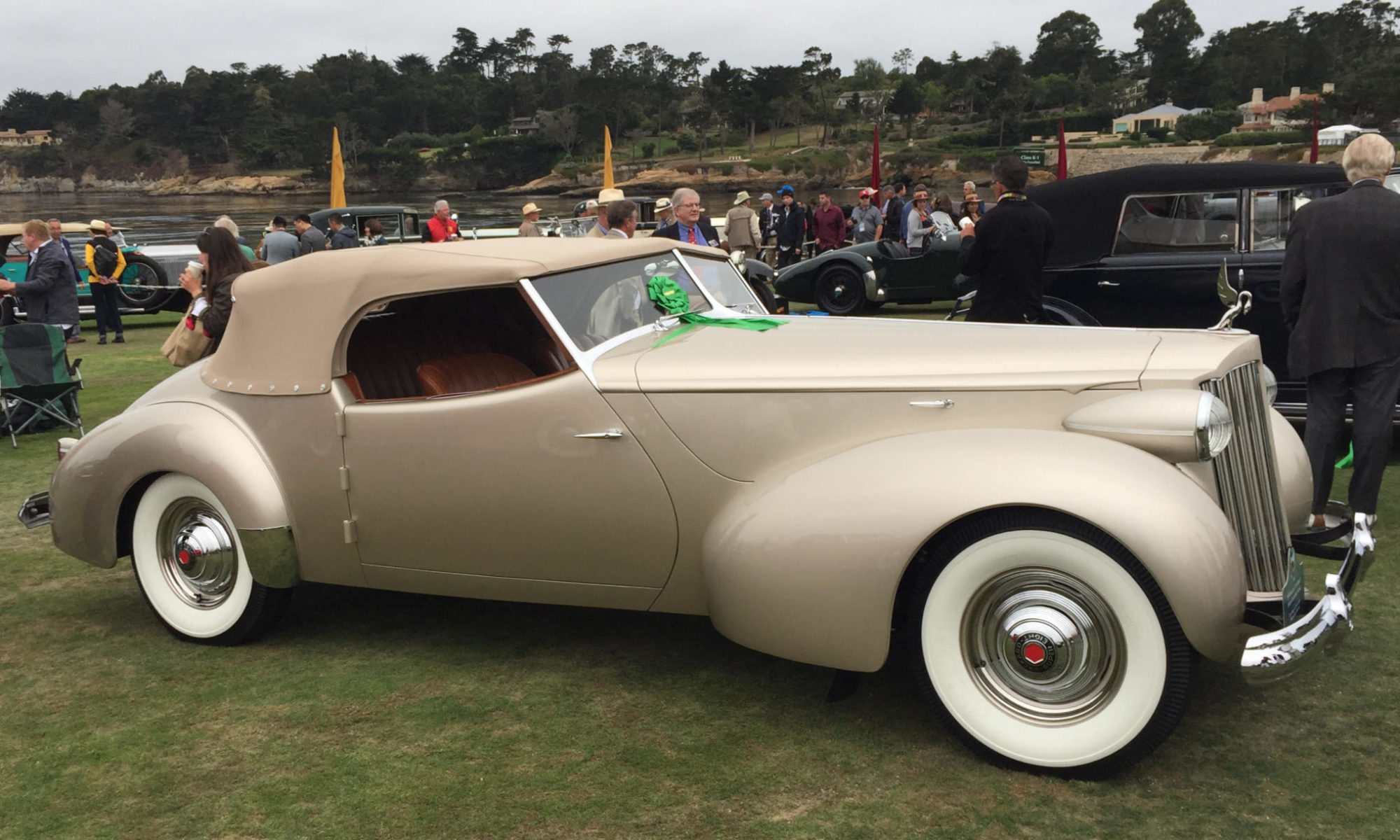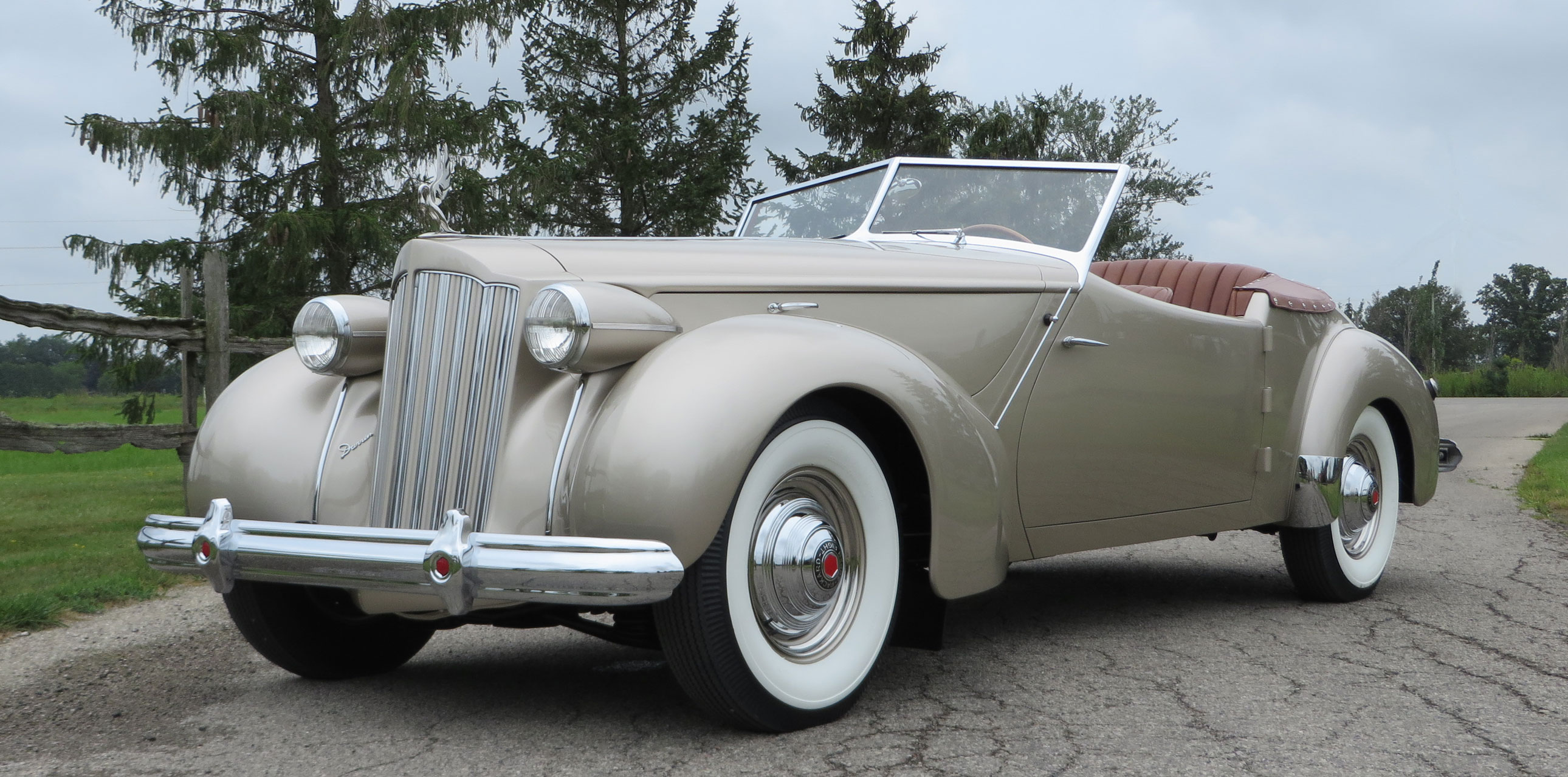 Owners: Leon Flagg & Curtis Lamon
Owners: Leon Flagg & Curtis Lamon
- Body Style: Convertible Victoria by Darrin of Paris, Hollywood, CA
- Series No. 1703
- Engine No. B504018
- Vehicle No. 1703-2005
- Cylinders: Straight 8; CID 320; 130bhp @ 3200 rpm
- Brakes: 4 drums
- Length: 201 5/8 in. Wheelbase 127in.
- Weight: approx 3900 lbs
Awards:
- First Place, The 54th Annual Packard Automobile Classics National Meet (Class 3D – Senior 8 Cylinder Convertibles 1939-1942) – W. Lafayette, IN – July 25, 2019
- Amelia Award, The 24th Amelia Island Concours d’Elegance (Class AC4 – American Classic 1938-1948) – The Ritz-Carlton, Amelia Island, FL – March 10, 2019
- Lion Award & Most Photogenic Grand Award, The 40th Concours d’Elegance of America (Class AP – Packard) – The Inn at St. John’s, Plymouth, MI – July 29, 2018
- Third in Class, The 67th Pebble Beach Concours d’Elegance (Class D – Packard) – Pebble Beach, CA – August 20, 2017
Evolution of a Masterpiece: From Paris to Hollywood
Paris. The City of Light had dimmed a bit by 1937. From his showroom on the Champs-Elysee, Howard “Dutch” Darrin, an American expat, had designed and built stylish coachwork on opulent European chassis, but uneasy markets and political upheaval scattered the aristocrats and tycoons who normally retained Hibbard & Darrin, later Fernandez & Darrin, to cloak their Delage or Hispano Suiza in flowing sheetmetal. Times, such as they were, had flattened the fizz in everyone’s champagne.
It was time to go home.
Never one to go quietly, charming, polo-playing “Dutch” turned up in a spot where life was still lived large—Hollywood. Darrin of Paris opened on Sunset Boulevard that same year. Here, Darrin evolved the work he’d done in Paris, imposing sensuous European curves into his work on forthright American chassis. Darrin favored the great, impeccably engineered Packard and his new cars stood out against a landscape of typically restrained domestic styling.
In creating his custom Packards in Hollywood, Darrin preferred to use the smaller One Twenty chassis, simply because it was less expensive. Accordingly, of the handbuilt “Darrins” produced in California prior to 1940, the vast majority were built on these smaller, less powerful platforms. It was only when a client specially requested a Super-8 version that it was constructed, using a club coupe bought and rebodied specifically for the occasion. Very few Super-8 “Darrins” were produced in Hollywood, with most historians agreeing on a total number of six. Ours is one of them.
On Sunset Boulevard, Darrin’s team incorporated Darrin-signature low-profile hood, down-swept doors and the chromed V’d windshield. A cast aluminum cowl, custom designed by Rudy Stoessel, was installed to strengthen the low-slung open car.
The movie crowd took notice. Contemporary owners of “Hollywood” Packard Darrins included stars: Clark Gable, Chester Morris, Dick Powell and Errol Flynn.
History of this Example
According to Edward Fallon, in his correspondence with a former owner, this particular car had been sold new in New York, and was traded to a psychiatrist as payment for services rendered in the late 1940s. It was later sold to a retired Navy chief petty officer in Virginia, who owned the car until it was acquired by Tom Mix of Boston, Massachusetts. Mr. Mix owned the famous Foreign Motors dealership and was an avowed Packard enthusiast. He acquired many of the cars in his renowned collection during the late 1950s, and it is likely that this car joined his stable at that time. Mix refinished the car cosmetically, painting it red, and removing the faux side exhaust that a well-meaning earlier owner had fitted.
In 1982 the car was purchased from Mix by David Taylor, a longtime Cadillac dealer with a small museum in Galveston, Texas. Mr. Taylor was known for collecting very low-mileage, original and well-maintained automobiles, with a superb eye for quality. He had the Darrin refinished in two-tone red by Bill Wallace, and kept it until 1991, when his museum closed. The Packard was then sold to Gilbert Hoard, from whom we acquired it in 1997.
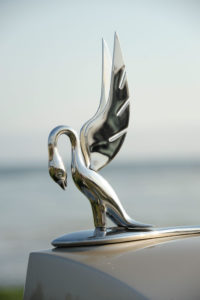
Identifying a Hollywood Darrin
Owners Leon and Curt are meticulous about history and authenticity, and endeavored to research this automobile as no other “Hollywood Darrin” had been researched before, to ensure that its restoration would be as correct as humanly possible. Darrin historians Donald Figone, Gene Tareshawty, and Robert Knee were all contacted for their input on the car’s history and authenticity, and they helped to confirm its originality. Mr. Fallon had also contacted the late Bob Turnquist and Norm Knight, both of whom, he reported, had come to the same conclusion.
Studying styling evolutions led to the conclusion that this was probably the second of six Super-8s built by Darrin at the Hollywood shop, as it is the only other known survivor with the top-opening hood featured on the first Super-8 “Darrin” built (now in the Stahl Automotive Foundation collection in Michigan). Mr. Figone notes that the car retains the cast aluminum cowl, designed by Darrin shop foreman Rudy Stoessel to strengthen the body; the short Packard factory rear deck and rear fenders; a sharp-cornered split windshield frame; and the 3-4-inch sill under the passenger doors, all found on the earliest “Darrins” and eliminated midway through the 1939 production. All of these are signature touches of the early Hollywood-built cars.
Further, the original chassis unit number of 5 was located, stamped on the left front frame horn.
Restoration of a Masterpiece: The Car “Dutch” Would Have Known
After careful consideration, RM Auto Restoration was selected to return the seventy-five year old car to her former glory. RM, well-known for their craftsmanship and attention to detail, further assisted in researching the car’s history, design and engineering; as well as in the selection of the most accurate materials incorporated in the finished restoration.
The body restoration of this car was relatively straightforward, having begun from a solid and intact example that retained its original Darrin cowl, braces, and other features. Examination of original period paint samples and color chips led to the selection of polychromatic Havana Beige, which was recreated using the best available paint materials.
Recreating the interior finishes proved its own exceptional challenge, and was, in fact, the most challenging facet of the concours-quality restoration.
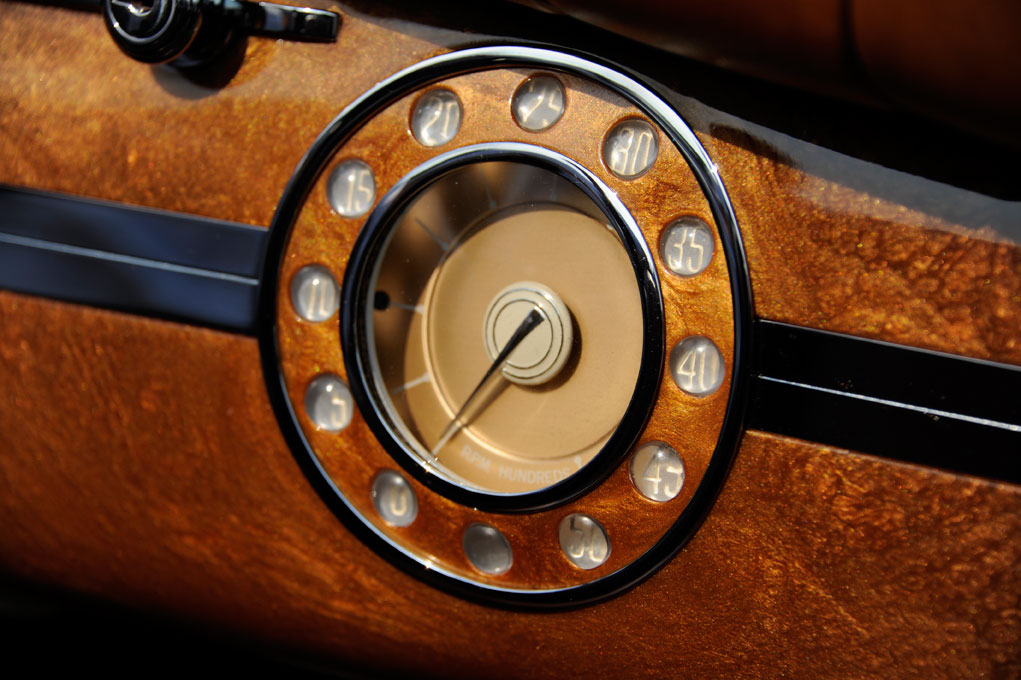
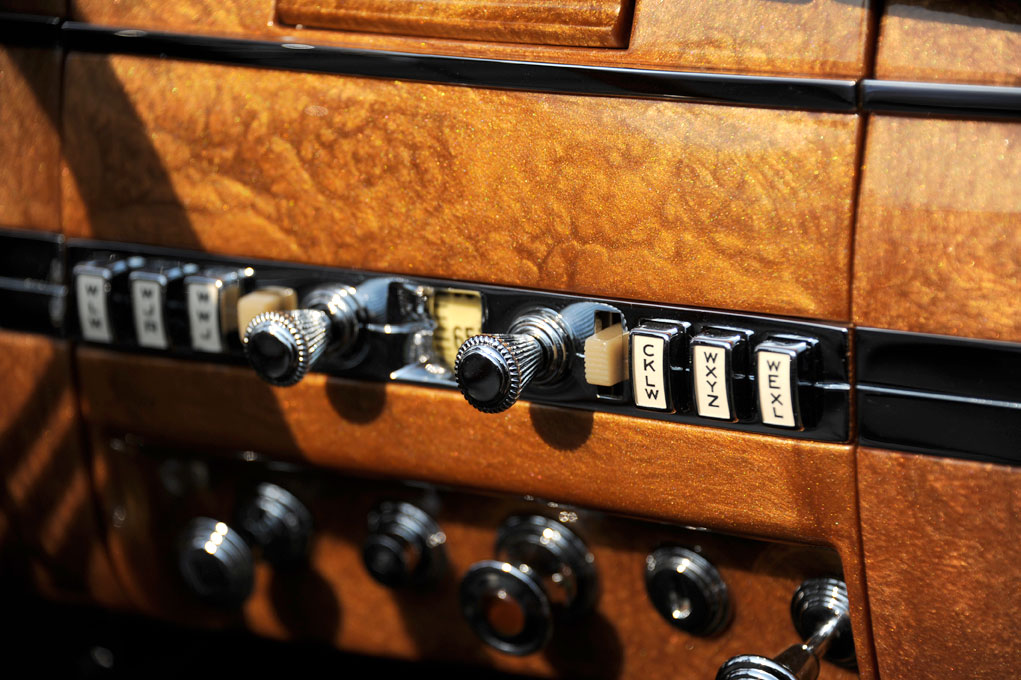
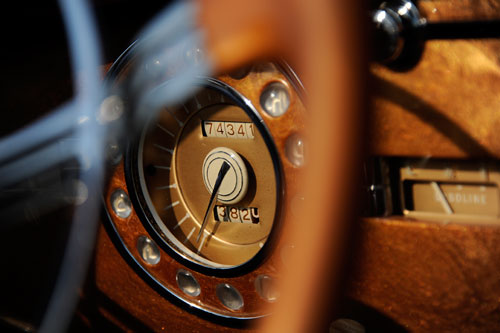
The 1939 Packard dashboard was originally made from Tenite, a very early “cellulosic thermoplastic.” These dashes crumbled over time, and very few originals are known to survive, even fewer of which are in usable condition. Efforts at acquiring a modern reproduction proved unsatisfactory, and so RM Auto Restoration endeavored to replicate the original dashboard from scratch. Having determined that the dashboard originally carried a “mica” dark mottled finish, molded into the plastic parts, a mold was created based on the original design. Thirteen different dashboards were cast before the woodgraining had been recreated with the correct effect. Proper bezels for the dashboard gauges were recreated from the same materials and with the same method, including the proper backlit and magnified lenses. We believe that this is the only surviving “Hollywood Darrin” with an exact duplicate of the original Tenite dashboard, down to the radio buttons marked with the same Detroit stations pictured in Packard brochures.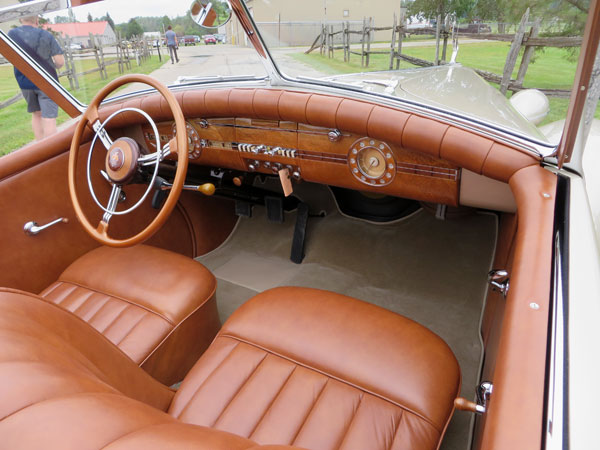
The recollections of “Dutch” Darrin himself, in the July 1967 issue of Car Classics, provided input into the correct finishes of the upholstery. “Darrin located an interior decorating supply firm, Clark and Burchfield, which was importing chrome-dyed leather from Germany, and purchased all his upholstery material there. He said the leather displayed genuine saddle quality and that it was nearly impossible to tell that it had been finished.” Accordingly, appropriate material was sourced and used to recreate this car’s original interior. Period photographs of original “Hollywood” cars also assisted in recreating both the interior pattern and the tapered leather top boot unique to the earliest “Darrins.”
The result of this exhaustive work and research is a “Hollywood Darrin” that is, as near as can possibly be presented, exactly the car that it was in 1939.
